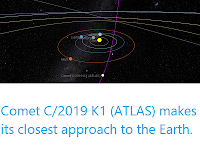Comet C/2020 F8 (SWAN) will make its closest approach to the
Earth on Wednesday 13 May 2020, reaching a distance of 0.57
AU from the Earth (47%
of the distance between the Earth and the Sun, or 85 034 000 km). At
this distance the comet will be not naked eye visible, having a
magnitude of 13.6, (roughly the same as asteroid 7 Hebe), but should be observable with a pair of binoculars or a small telescope, in the Constellation of Pisces, which is visible from anywhere on Earth.
C/2020 F8 (SWAN) imaged from Show EXIF Lamanggau in Southeast Sulawesi, Indonesia, on 1 May 2020. Five minute exposure using a Celestron 5SE telescope with a ZWO ASI 295MC PRO camera . Christian Gloor/Flikr/Wikimedia Commons.
C/2020 F8 (SWAN) was discovered on 25 March 2020 by the SWAN camera on the Solar and Heliospheric Observertory spacecraft. The designation C/2020 F8 (SWAN) indicates that it was the eighth (8) comet (C/) discovered in the second half of March 2020 (period 2020 F), and that it was discovered by the SWAN camera (SWAN).
The orbit and current position of C/2020 F8 (SWAN). The Sky Live 3D Solar System Simulator.
C/2020 F8 (SWAN) is a Parabolic Comet, which is to say a comet that
has been disrupted from an orbit in the Oort Cloud, and to be passing
through the Inner Solar System on a parabolic orbit that will probably
not bring it back again. This parabolic trajectory tilted
at an angle of 111° to the plain of the Solar System, that will bring it it
in to 0.64 AU from the Sun at perihelion (i.e. 0.64 times as far from
the Sun as the planet Earth and inside the orbit of the planet Venus) on 26 May 2020.
See also...
Follow Sciency Thoughts on Facebook.








